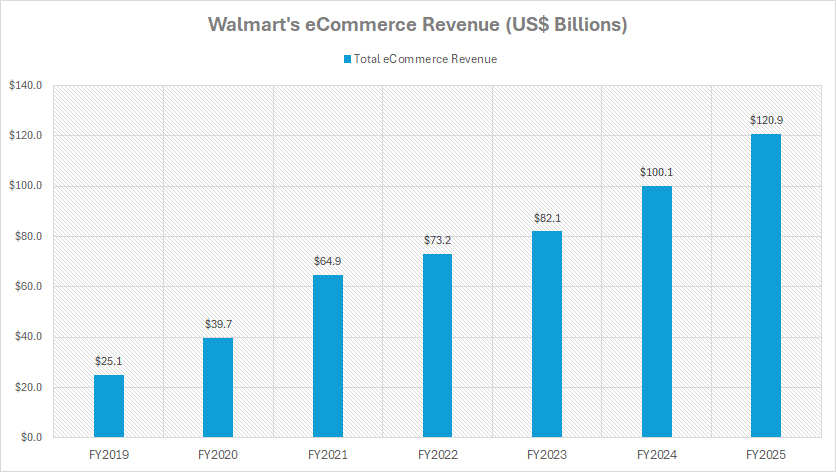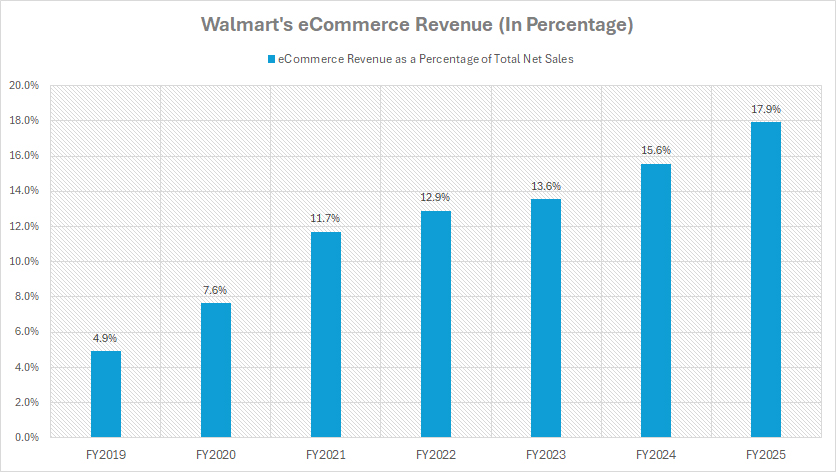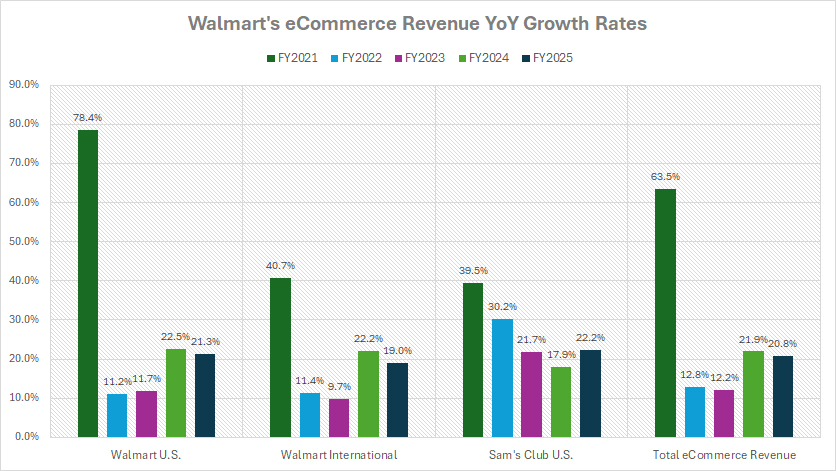
Eggs. Pexels Images.
This article presents Walmart’s eCommerce revenue.
Walmart’s online sales are divided into three primary units: Walmart U.S., Walmart International, and Sam’s Club U.S.
Let’s take a look!
For other key statistics of Walmart, you may find more resources on these pages:
Revenue
- Revenue by country: U.S. and International,
- Revenue breakdown: net sales and membership & other income,
- Revenue by segment: U.S., International, and Sam’s Club
Profit Margin
- Profit margin breakdown: U.S., International, and Sam’s Club,
- Walmart vs Costco: profit margin comparison
Other Statistics
- Capital expenditures breakdown,
- Comparable sales by calendar period,
- revenue per store
Please use the table of contents to navigate this page.
Table Of Contents
Definitions And Overview
O2. What drives the significant growth in Walmart’s online revenue?
Consolidated Results
A1. Total eCommerce Revenue
A2. eCommerce Revenue as a Percentage of Net Sales
Results By Region
B1. eCommerce Revenue From Walmart U.S., International, and Sam’s Club
B2. Percentage Of eCommerce Revenue From Walmart U.S., International, and Sam’s Club
Revenue Growth
C1. eCommerce Revenue YoY Growth Rates
Summary And Reference
S1. Insight
S2. References and Credits
S3. Disclosure
Definitions
To help readers understand the content better, the following terms and glossaries have been provided.
eCommerce Revenue: Walmart’s eCommerce revenue refer to the sales generated through its eCommerce platforms, including its website and mobile app.
This encompasses a wide range of products and services, from groceries and household items to electronics and fashion, all available for delivery or pickup.
Walmart’s online sales have been a significant driver of its growth, with global eCommerce revenue surpassing $120 billion in the latest result.
Net Sales: Walmart’s net sales refer to the total revenue generated by the company through its retail and eCommerce operations after deducting returns, discounts, and allowances.
This figure excludes membership income and represents the core income from selling goods and services across its segments, including Walmart U.S., Walmart International, and Sam’s Club.
Net sales are a critical metric used to assess the company’s financial performance and operational effectiveness.
Walmart U.S.: Walmart U.S. stands as the company’s largest segment, operating 4,605 stores across the United States, spanning all 50 states, Washington D.C., and Puerto Rico.
As a leading mass merchandiser of consumer products, Walmart U.S. serves customers under the “Walmart” and “Walmart Neighborhood Market” brands, as well as through its digital platform, walmart.com.
With a focus on convenience and integration, Walmart U.S. delivers a seamless omni-channel shopping experience by blending its physical retail locations with eCommerce services.
Nearly all stores offer same-day pickup and delivery options, including features like express delivery within 90 minutes, in-home delivery, and digital pharmacy services.
The Walmart+ membership program enhances this omni-channel approach, offering benefits such as unlimited free shipping with no minimum purchase, unlimited delivery from stores, fuel discounts, mobile Scan & Go capabilities, and exclusive perks for members.
Strategically, Walmart U.S. operates within three core merchandise categories: Grocery, General merchandise, and Health and wellness.
Walmart International: Walmart International ranks as the company’s second largest segment, operating 5,566 stores across 18 countries outside of the United States.
The segment functions through wholly-owned subsidiaries in Canada, Chile, China, and Africa (covering nations such as Botswana, Lesotho, Malawi, Mozambique, Namibia, South Africa, Eswatini, and Zambia), alongside majority-owned subsidiaries in India, and in Mexico and Central America (including Costa Rica, El Salvador, Guatemala, Honduras, and Nicaragua).
Walmart International spans diverse formats under two main categories: retail and wholesale. These include supercenters, supermarkets, warehouse clubs like the membership-only Sam’s Club, cash-and-carry stores, and robust eCommerce offerings via websites and mobile apps like walmart.com.mx, walmart.ca, flipkart.com, PhonePe, and others.
The division’s strategy revolves around “bringing Walmart to the world and the world to Walmart.” This means leveraging its global network and localized expertise to deliver affordable products and services, helping millions of customers and members save money and live better daily.
A seamless omni-channel shopping experience is a cornerstone of Walmart International’s approach, integrating physical retail stores with eCommerce. This includes pickup and delivery services across most markets, with same-day delivery as a prominent feature.
Marketplace expansions also play a significant role, opening doors to enhanced fulfillment and advertising services. Walmart International’s merchandising strategy mirrors the breadth and depth of Walmart U.S., ensuring customers access a wide variety of products.
Sam’s Club U.S.: Sam’s Club U.S. operates as a membership-only warehouse club with 600 locations across 44 states in the U.S. and Puerto Rico, alongside its online platform, samsclub.com.
Committed to offering a fast and seamless omni-channel experience, Sam’s Club U.S. integrates physical clubs with eCommerce solutions.
Members enjoy convenient services such as curbside pickup for contact-free shopping, the Scan & Go mobile checkout for skipping lines, and the innovative Just Go feature, introduced in fiscal 2025, which enables frictionless exits.
The club provides merchandise across four key categories: Grocery, General merchandise, Health and wellness, and Fuel.
Memberships come with added value, including a spouse/household card at no extra cost. Club members benefit from free curbside pickup for orders of $50 or more, while Plus members enjoy additional perks such as complimentary delivery-from-club, free shipping on $50+ orders, exclusive discounts, convenience features, and early access to shopping before regular hours.
Beginning in fiscal 2023, Sam’s Club U.S. launched a rewards program allowing members to earn Sam’s Cash on purchases, which can be redeemed for cash, used for future purchases, or applied toward membership fees.
Omni-Channel: Omni-channel refers to a strategy in commerce and customer engagement that provides a seamless and integrated experience across all channels, whether they are online, offline, or hybrid. It’s about making every interaction — from browsing products online to visiting a physical store—feel connected and consistent.
For example:
-
In retail, omni-channel could mean a customer can browse products online, reserve an item on a mobile app, and pick it up in-store, all while receiving consistent information and support.
-
In customer service, omni-channel ensures that whether a customer contacts a company via email, chat, phone, or social media, their inquiries and interactions are unified across these platforms.
The key idea is to break down silos between channels and prioritize the customer’s convenience. Businesses that adopt omni-channel approaches often see improved customer satisfaction and loyalty.
What drives the significant growth in Walmart’s online revenue?
Walmart’s online revenue growth is driven by several key factors:
-
Omnichannel Strategy: Walmart leverages its extensive network of physical stores to support online sales through services like curbside pickup and same-day delivery.
-
Technology Investments: Automation in fulfillment centers and advanced digital tools have enhanced efficiency and customer experience.
-
Walmart Connect: The company’s advertising business has grown significantly, contributing to its eCommerce revenue.
-
Membership Programs: Walmart Plus and Sam’s Club memberships provide additional value and convenience, boosting customer loyalty.
-
Competitive Pricing: Walmart consistently offers lower prices, attracting cost-conscious consumers.
-
Adaptability: The company has successfully navigated shifts in consumer behavior, especially during the pandemic, by expanding delivery services and partnerships.
These factors collectively contribute to the growth in Walmart’s online sales, reflecting its efforts to adapt to changing consumer preferences and market dynamics.
Total eCommerce Revenue
Walmart-eCommerce-revenue
(click image to expand)
Walmart’s operating segments consist of Walmart U.S., Walmart International and Sam’s Club U.S. The definitions of these segments are available here: Walmart U.S., Walmart International, and Sam’s Club U.S.
For the definition of Walmart’s online revenue, you may refer to this section: eCommerce revenue.
Walmart achieved remarkable growth in eCommerce, reaching a total revenue of $120.9 billion for fiscal year 2025, a significant 21% increase from the $100 billion recorded in fiscal year 2024.
In previous years, Walmart reported global eCommerce revenues of approximately $73 billion in fiscal year 2022 and $82 billion in fiscal year 2023.
Since fiscal year 2019, Walmart’s eCommerce operations have expanded dramatically, with revenue soaring from $25 billion to the current figure of $120.9 billion, representing nearly a fivefold increase in just six years.
eCommerce Revenue as a Percentage of Net Sales
Walmart-eCommerce-revenue-in-percentage
(click image to expand)
Walmart’s operating segments consist of Walmart U.S., Walmart International and Sam’s Club U.S. The definitions of these segments are available here: Walmart U.S., Walmart International, and Sam’s Club U.S.
For the definition of Walmart’s net sales, you may refer to this section: net sales.
From a percentage standpoint, Walmart’s eCommerce revenue accounted for approximately 18% of its total net sales in fiscal year 2025, as illustrated in the chart above.
This marks a substantial rise from just 5% in fiscal year 2019 to the current 18%, underscoring the growing importance of Walmart’s eCommerce segment in driving overall sales performance.
eCommerce Revenue From Walmart U.S., International, and Sam’s Club
Walmart-eCommerce-revenue-breakdown
(click image to expand)
Walmart’s operating segments consist of Walmart U.S., Walmart International and Sam’s Club U.S. The definitions of these segments are available here: Walmart U.S., Walmart International, and Sam’s Club U.S.
For the definition of Walmart’s online revenue, you may refer to this section: eCommerce revenue.
In fiscal year 2025, Walmart U.S. generated the highest eCommerce revenue among all segments, reaching $79.3 billion, a notable increase from the $65.4 billion recorded in fiscal year 2024.
Walmart International contributed $29.5 billion in eCommerce revenue for fiscal year 2025, ranking second among the segments. This marks a steady rise from $24.8 billion achieved in fiscal year 2024.
Sam’s Club U.S. reported $12.1 billion in eCommerce revenue for fiscal year 2025, the lowest across all segments. However, this represents a significant growth from the $10 billion reported in fiscal year 2024.
Overall, Walmart’s eCommerce revenue across all segments has experienced remarkable growth since fiscal year 2019.
Percentage Of eCommerce Revenue From Walmart U.S., International, and Sam’s Club
Walmart-eCommerce-revenue-breakdown-in-percentage
(click image to expand)
Walmart’s operating segments consist of Walmart U.S., Walmart International and Sam’s Club U.S. The definitions of these segments are available here: Walmart U.S., Walmart International, and Sam’s Club U.S.
For the definition of Walmart’s online revenue, you may refer to this section: eCommerce revenue.
In fiscal year 2025, Walmart’s U.S. division accounted for 66% of the company’s total eCommerce revenue — a consistent figure over recent years, reflecting substantial growth from 62.5% in fiscal year 2019.
Conversely, Walmart International’s eCommerce revenue share decreased to 24.4% in fiscal year 2025, down from its peak of nearly 30% in fiscal year 2020.
Sam’s Club U.S. contributed the smallest portion, representing only 10% of Walmart’s eCommerce revenue in fiscal year 2025.
eCommerce Revenue YoY Growth Rates
Walmart-eCommerce-revenue-yoy-growth-rates
(click image to expand)
Walmart’s operating segments consist of Walmart U.S., Walmart International and Sam’s Club U.S. The definitions of these segments are available here: Walmart U.S., Walmart International, and Sam’s Club U.S.
For the definition of Walmart’s online revenue, you may refer to this section: eCommerce revenue.
On a consolidated level, Walmart achieved a global eCommerce revenue growth rate of 21% in fiscal year 2025, maintaining steady progress compared to the 22% growth recorded in fiscal year 2024.
Among the segments, Sam’s Club U.S. delivered the strongest growth, with eCommerce revenue increasing by 22% in fiscal year 2025.
Meanwhile, the Walmart U.S. division posted a solid 21% growth, closely aligning with the overall trend. Walmart International, though slightly behind, reported a respectable growth rate of 19% during the same period.
Over the period from fiscal year 2021 to 2025, Walmart’s consolidated eCommerce revenue achieved a remarkable 5-year average growth rate of 26%.
Among its segments, the Walmart U.S. division led the way with the highest average annual growth rate of 29%, showcasing its strong performance and strategic focus.
Meanwhile, Walmart International posted a 21% 5-year average annual growth rate, reflecting steady progress across global markets. Sam’s Club U.S. maintained a notable growth rate of 26%, demonstrating its contribution to Walmart’s overall eCommerce expansion.
Insight
Walmart has successfully transformed its eCommerce segment into a vital driver of its growth strategy. Since fiscal year 2019, Walmart’s global eCommerce revenue has expanded nearly fivefold, from $25 billion to $120.9 billion in fiscal year 2025.
This growth highlights its commitment to innovation, adaptability, and leveraging its omnichannel strategy to seamlessly integrate physical stores with digital platforms.
Key contributing factors include consistent investments in technology, customer-focused membership programs, and a robust logistics network supporting services like same-day delivery.
Additionally, while Walmart U.S. continues to dominate with the largest share of eCommerce revenue, international markets and Sam’s Club have also demonstrated noteworthy growth, underscoring the effectiveness of Walmart’s global strategy.
Overall, Walmart’s efforts showcase its ability to adapt to shifting consumer behaviors and maintain competitiveness in a rapidly evolving retail landscape.
References and Credits
1. All financial figures presented were obtained and referenced from Walmart’s annual reports published on the company’s investor relations page: Walmart Investor Relations.
2. Pexels Images.
Disclosure
We may use artificial intelligence (AI) tools to assist us in writing some of the text in this article. However, the data is directly obtained from original sources and meticulously cross-checked by our editors multiple times to ensure its accuracy and reliability.
If you find the information in this article helpful, please consider sharing it on social media. Additionally, providing a link back to this article from any website can help us create more content like this in the future.
Thank you for your support and engagement! Your involvement helps us continue to provide high-quality, reliable content.





